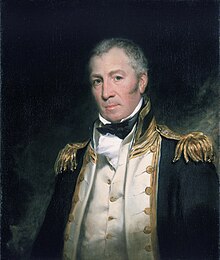
Back بيتر هيهوود Arabic Peter Heywood German Peter Heywood Spanish Peter Heywood French Peter Heywood ID ピーター・ヘイウッド Japanese पीटर हेवूड Marathi Peter Heywood Dutch Peter Heywood Portuguese Хейвуд, Питер Russian
Peter Heywood | |
|---|---|
 Portrait by John Simpson | |
| Born | 6 June 1772 Douglas, Isle of Man |
| Died | 10 February 1831 (aged 58)[citation needed] London |
| Allegiance | United Kingdom |
| Service/ | Royal Navy |
| Years of service | 1786–1816 |
| Rank | Captain |
| Commands held | HMS Amboyna HMS Vulcan HMS Trincomalee HMS Trident HMS Leopard HMS Dedaigneuse HMS Polyphemus HMS Donegal HMS Nereus HMS Montagu |
| Known for | Mutiny on the Bounty |
| Battles/wars | |
| Alma mater | St Bees School |
| Spouse(s) | Frances Joliffe |
| Children | One daughter[n 1] |
| Relations | Sir Thomas Pasley (uncle) |
Captain Peter Heywood (6 June 1772 – 10 February 1831) was a British Royal Navy officer who was on board HMS Bounty during the mutiny of 28 April 1789. He was later captured in Tahiti, tried and condemned to death as a mutineer, but subsequently pardoned. He resumed his naval career and eventually retired with the rank of post-captain, after 29 years of honourable service.
The son of a prominent Isle of Man family with strong naval connections, Heywood joined Bounty under Lieutenant William Bligh at the age of 15. Although unranked, he was granted the privileges of a junior officer. Bounty left England in 1787 on a mission to collect and transport breadfruit from the Pacific, and arrived in Tahiti late in 1788. Relations between Bligh and certain of his officers, notably Fletcher Christian, became strained, and worsened during the five months that Bounty remained in Tahiti.
Shortly after the ship began its homeward voyage, Christian and his discontented followers seized Bligh and took control of the vessel. Bligh and 18 loyalists were set adrift in an open boat; Heywood was among those who remained with Bounty. Later, he and 15 others left the ship and settled in Tahiti, while Bounty sailed on, ending its voyage at Pitcairn Island. Bligh, after an epic open-boat journey, eventually reached England, where he implicated Heywood as one of the mutiny's prime instigators. In 1791, Heywood and his companions were met in Tahiti by the search vessel HMS Pandora. Heywood and one other sailor welcomed the Pandora in canoes, relieved to be rescued. However, they were arrested; the captain, Edward Edwards, had them and 12 others fettered and handcuffed in an 11-foot (3.4 m) box built for the purpose on deck. During their subsequent journey, Pandora was wrecked on the Great Barrier Reef, and four of Heywood's fellow prisoners drowned.
In September 1792, Heywood was court-martialed and with five others was sentenced to hang. However, the court recommended mercy for Heywood, and King George III pardoned him. In a rapid change of fortune, he found himself favoured by senior officers, and after the resumption of his career, received a series of promotions that gave him his first command at the age of 27 and made him a post-captain at 31. He remained in the navy until 1816, building a respectable career as a hydrographer, and then enjoyed a long and peaceful retirement.
The extent of Heywood's true guilt in the mutiny has been clouded by contradictory statements and possible false testimony. During his trial powerful family connections worked on his behalf, and he later benefited from the Christian family's generally fruitful efforts to demean Bligh's character and present the mutiny as an understandable reaction to an unbearable tyranny. Contemporary press reports and more recent commentators have contrasted Heywood's pardon with the fate of his fellow prisoners who were hanged, all lower-deck sailors without wealth or family influence and who lacked legal counsel.
Cite error: There are <ref group=n> tags on this page, but the references will not show without a {{reflist|group=n}} template (see the help page).